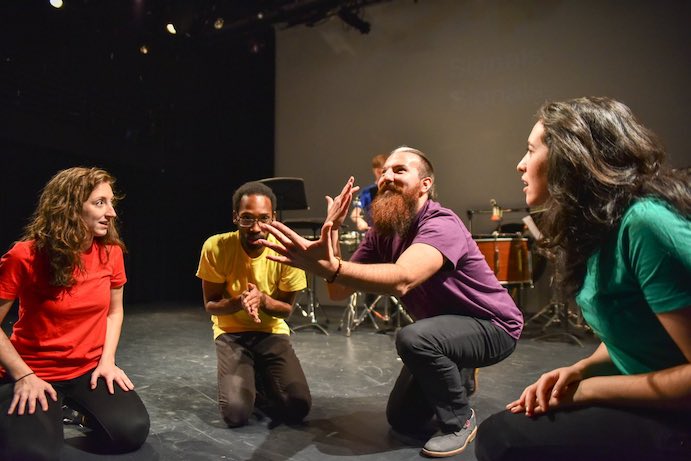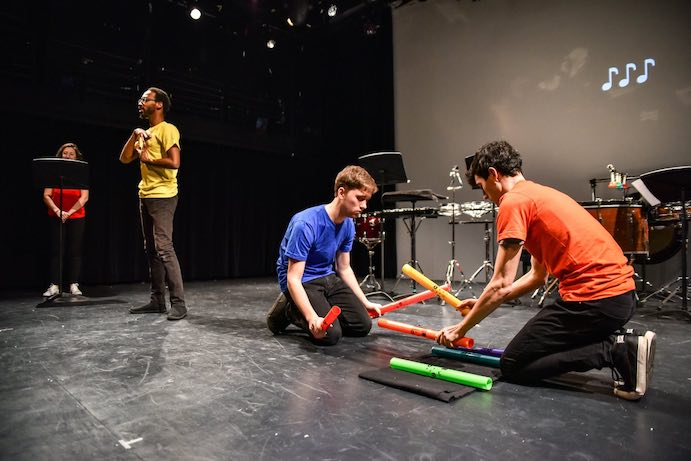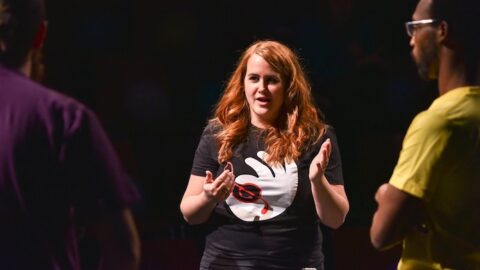SIGN & SING was founded in 2015 by Princeton University alumna Katherine Dubbs as a way to make opera and new music for all audiences. Deaf actors, singers, percussionists, and other musicians form a unique network of collaborators, bringing a wide range of repertoire to life in a way that is both deeply moving and incredibly accessible. Since its founding, SIGN and SING has maintained an active schedule of exciting programming, offering concerts in New York City (at the National Opera Center and Dixon Place, among others), and on college campuses, from Gallaudet to Princeton. We asked Katherine about the vision behind SIGN & SING and her plans for the future.
Creating truly excellent musical experiences for Deaf audiences is a major development in the world of Classical music. Please share with us your inspiration, personal and/or professional, behind the creation of SIGN & SING.
My family consists of Deaf, Hard of Hearing, and Hearing members, and I remember my aunt attending a performance I produced that wasn’t accessible. That need for inclusion inspired me to create an accessible performance for her and for the rest of my family, which is why SIGN & SING was first created.
As the company matured, we realized that the most powerful works were entirely new music-based, so we have grown to focus on that. Now, SIGN & SING creates new operatic works in English and American Sign Language (ASL) with Deaf poets, Deaf or deaf composers, and Deaf actors. Our works discuss listening, communication, and accessibility.
You’ve had an ambitious year. What can audiences expect from you next season?
As seen in the photos, SIGN & SING is very proud of our last work, The Universal Drum, written by Deaf poet Willy Conley and composer Brad Balliett. That work was also a partnership with Gallaudet University, in which Deaf students contributed to the interpretation of the ASL. It was a very collaborative work, including audience participation with egg shakers.
Our new upcoming work is also a commission, this time by deaf composer Richard Einhorn. The work, Bell, will be workshopped in Hartford, Connecticut on May 16 and May 17, 2020. The performances will be free, and more information can be found on our website.
We’re also developing another ASL-opera, and more information will be released soon! It’s an exciting time.

The singers and the signers must work closely with each other–sometimes, they are only inches from each other, inhabiting the same character and expressing the music and text in different mediums (rather than having a signer off to the side, uninvolved with the action, for example). This is a unique arrangement, and seemingly not a simple one to navigate. How do the performers build a rapport with each other and with their audiences? What are the challenges inherent to this setup, and how are they addressed?
We try to transform how stories are told. Sometimes, an actor and a singer share a character together. Other times, they are unique storytellers communicating in different languages. Their roles can shift even over the course of one work. Clarity must come from the strength of the ASL interpretation, and the music must support the drama presented in the sign.
Like in other opera rehearsal rooms, SIGN & SING works in two languages at once. We rely on interpreters and are communicating in multiple ways. This requires a lot of flexibility and patience from all of our performers.
It’s important, in particular for our audience, that everything is translated into English and ASL at the same time and that we feature multiple means of access. Our audiences feature signers and non-signers alike, so some audience members prefer assistive listening devices and open captions, while other audience members focus exclusively on the ASL. For those audience members who like to feel the vibrations of the instruments, for example, we provide balloons.
Every performer is different, and every audience member is different. The key is to keep asking and keep adjusting.
You’ve already built many partnerships with established organizations from universities to performance venues, clubs, etc.. Where would you like to see SIGN & SING go next, and are there any audiences that you would you like to reach in particular?
We’re looking forward to performing in Connecticut next May, since Hartford is the home to the American School for the Deaf. We will also be collaborating with a string quartet, Cuatro Puntos, a new instrumental arrangement for our work. SIGN & SING’s work is chamber-sized in nature, so collaborating with chamber ensembles seems like a logical extension and next step for our new upcoming projects.
In the future, SIGN & SING would love to tour our productions to Deaf schools across the country. At the same time, we love the intimacy of our New York performances. Sight lines of ASL require the audience to be 200 people or fewer in a standard shoebox space, so we will continue work in this way. Video has been a successful platform for us to share our work to a larger audience, and I look forward to recording more of our intimate performances. University settings have also been beneficial, since their venues are ADA compliant.

You have created a niche within a field that has made comparatively little effort to court Deaf audiences. What have been some of the most challenging parts of this endeavor and conversely, what have been some of the most inspirational and rewarding parts of your job. As a follow up, how can other organizations work with SIGN & SING to learn from your work and expand their audiences to include Deaf individuals?
If there’s anything I have learned from SIGN & SING in the past few years, it’s be willing to change. We didn’t get it right the first concert, and we didn’t get it totally right the second concert. We really hit our stride in our third year, but we are still making adjustments and looking to improve. Asking for help and staying flexible has allowed SIGN & SING’s works to grow.
Due to the intricacies logistically and artistically in our work, SIGN & SING is also committed to staying small in scope. We have learned to embrace partnerships and to avoid expanding too quickly. Accessibility is a commitment that needs to be done right and needs to be done well, so it takes time and practice.
I love that in all SIGN & SING projects, no one is an expert. Someone will be a classically trained musician. Someone will be a professional Deaf actor. No one will be both. Same with our audiences. Everyone will come away learning something.
There are many wonderful resources available, nationally and locally, to help companies make their performances more accessible and more inclusive. Most importantly, ask your audiences: what do you need? Don’t bring in an ASL interpreter if your audience members do not use ASL. Don’t hand out assistive listening devices to audience members who prefer sign. You won’t know until you ask.
























